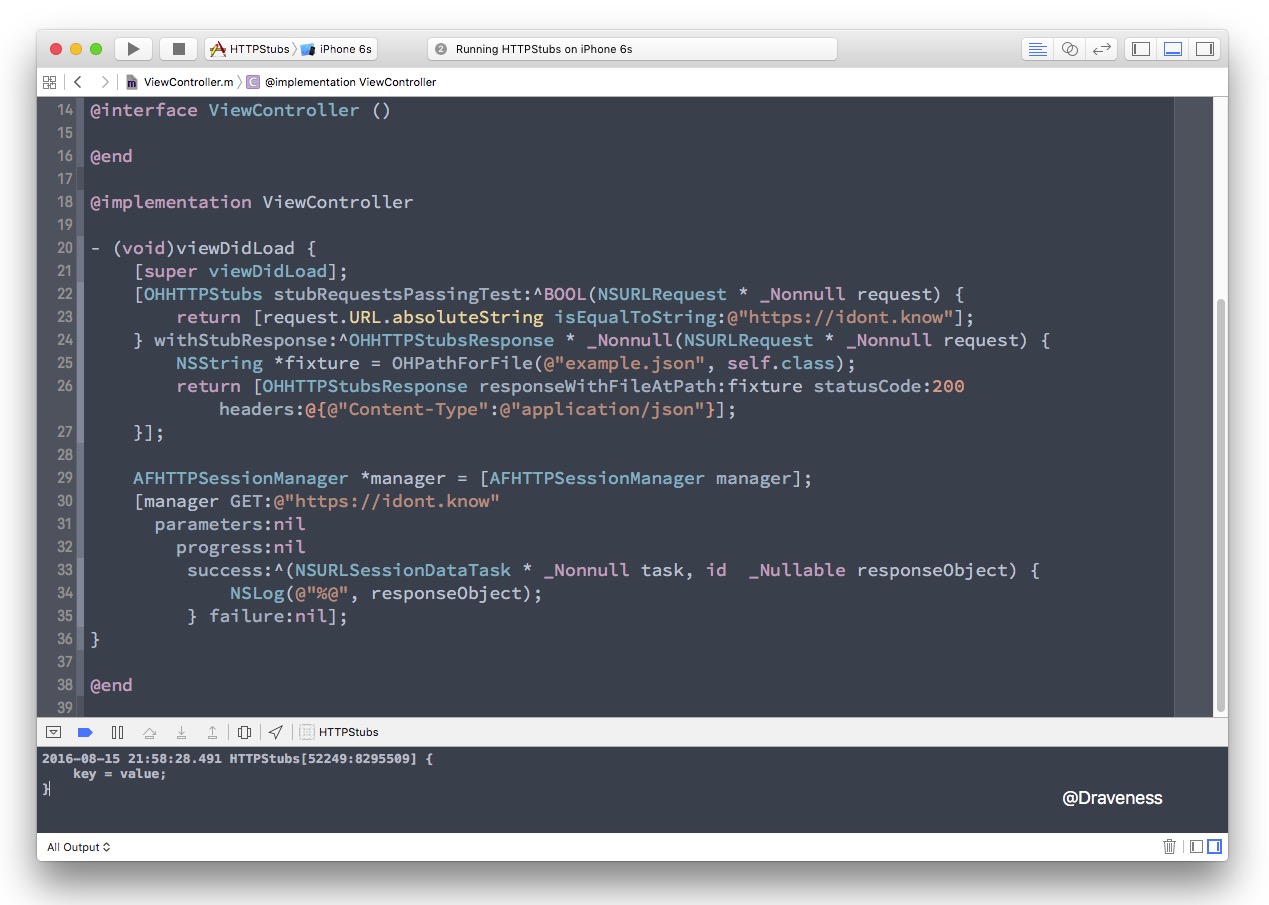如何进行 HTTP Mock(iOS)

这篇文章会对OHHTTPStubs 源代码的分析,其实现原理是建立在 NSURLProtocol 的基础上的,对这部分内容不了解的读者,可以阅读这篇文章 iOS 开发中使用 NSURLProtocol 拦截 HTTP 请求 了解相关知识,本文中不会介绍拦截 HTTP 请求的原理。
如何使用 OHHTTPStubs Mock 网络请求
HTTP Mock 在测试中非常好用,我们可以在不需要后端 API 的情况下,在本地对 HTTP 请求进行拦截,返回想要的 json 数据,而 OHHTTPStubs 就为我们提供了这样一种解决方案。
在了解其实现之前,先对 OHHTTPStubs 进行简单的介绍,引入头文件这种事情在这里会直接省略,先来看一下程序的源代码:
[OHHTTPStubs stubRequestsPassingTest:^BOOL(NSURLRequest * _Nonnull request) {
return [request.URL.absoluteString isEqualToString:@"https://idont.know"];
} withStubResponse:^OHHTTPStubsResponse * _Nonnull(NSURLRequest * _Nonnull request) {
NSString *fixture = OHPathForFile(@"example.json", self.class);
return [OHHTTPStubsResponse responseWithFileAtPath:fixture statusCode:200 headers:@{@"Content-Type":@"application/json"}];
}];
AFHTTPSessionManager *manager = [AFHTTPSessionManager manager];
[manager GET:@"https://idont.know"
parameters:nil
progress:nil
success:^(NSURLSessionDataTask * _Nonnull task, id _Nullable responseObject) {
NSLog(@"%@", responseObject);
} failure:nil];
我们向 https://idont.know 这个 URL 发送一个 GET 请求,虽然这个 URL 并不存在,但是这里的代码通过 HTTP stub 成功地模拟了 HTTP 响应:

OHHTTPStubs 的实现
在了解了 OHHTTPStubs 的使用之后,我们会对其实现进行分析,它分成四部分进行:
-
OHHTTPStubsProtocol拦截 HTTP 请求 -
OHHTTPStubs单例管理OHHTTPStubsDescriptor实例 -
OHHTTPStubsResponse伪造 HTTP 响应 - 一些辅助功能
OHHTTPStubsProtocol 拦截 HTTP 请求
在 OHHTTPStubs 中继承 NSURLProtocol 的类就是 OHHTTPStubsProtocol ,它在 HTTP 请求发出之前对 request 对象进行过滤以及处理:
+ (BOOL)canInitWithRequest:(NSURLRequest *)request {
return ([OHHTTPStubs.sharedInstance firstStubPassingTestForRequest:request] != nil);
}
- (id)initWithRequest:(NSURLRequest *)request cachedResponse:(NSCachedURLResponse *)response client:(id<NSURLProtocolClient>)client {
OHHTTPStubsProtocol* proto = [super initWithRequest:request cachedResponse:nil client:client];
proto.stub = [OHHTTPStubs.sharedInstance firstStubPassingTestForRequest:request];
return proto;
}
+ (NSURLRequest *)canonicalRequestForRequest:(NSURLRequest *)request {
return request;
}
判断请求是否会被当前协议对象进行处理是需要 OHHTTPStubs 的实例方法 - firstStubPassingTestForRequest: 的执行的,在这里暂时先不对这个方法进行讨论。
接下来就是请求发送的过程 - startLoading 方法了,该方法的实现实在是太过于复杂,所以这里分块来分析代码:
- (void)startLoading {
NSURLRequest* request = self.request;
id<NSURLProtocolClient> client = self.client;
OHHTTPStubsResponse* responseStub = self.stub.responseBlock(request);
if (OHHTTPStubs.sharedInstance.onStubActivationBlock) {
OHHTTPStubs.sharedInstance.onStubActivationBlock(request, self.stub, responseStub);
}
...
}
从当前对象中取出 request 以及 client 对象,如果 OHHTTPStubs 的单例中包含 onStubActivationBlock ,就会执行这里的 block,然后调用 responseBlock 获取一个 OHHTTPStubsResponse HTTP 响应对象。
OHHTTPStubs 不只提供了 onStubActivationBlock 这一个钩子,还有以下 block:
-
+ onStubActivationBlock:stub 被激活时调用 -
+ onStubRedirectBlock:发生重定向时 -
+ afterStubFinishBlock:在 stub 结束时调用
如果响应对象的生成没有遇到任何问题,就会进入处理 Cookie、重定向、发送响应和模拟数据流的过程了。
- 首先是对 Cookie 的处理
NSHTTPURLResponse* urlResponse = [[NSHTTPURLResponse alloc] initWithURL:request.URL
statusCode:responseStub.statusCode
HTTPVersion:@"HTTP/1.1"
headerFields:responseStub.httpHeaders];
if (request.HTTPShouldHandleCookies && request.URL) {
NSArray* cookies = [NSHTTPCookie cookiesWithResponseHeaderFields:responseStub.httpHeaders forURL:request.URL];
if (cookies) {
[NSHTTPCookieStorage.sharedHTTPCookieStorage setCookies:cookies forURL:request.URL mainDocumentURL:request.mainDocumentURL];
}
}
- 如果 HTTP 状态码在 300-400 之间,就会处理重定向的问题,调用
onStubRedirectBlock进行需要的回调
NSString* redirectLocation = (responseStub.httpHeaders)[@"Location"];
NSURL* redirectLocationURL = redirectLocation ? [NSURL URLWithString:redirectLocation] : nil;
if (((responseStub.statusCode > 300) && (responseStub.statusCode < 400)) && redirectLocationURL) {
NSURLRequest* redirectRequest = [NSURLRequest requestWithURL:redirectLocationURL];
[self executeOnClientRunLoopAfterDelay:responseStub.requestTime block:^{
if (!self.stopped) {
[client URLProtocol:self wasRedirectedToRequest:redirectRequest redirectResponse:urlResponse];
if (OHHTTPStubs.sharedInstance.onStubRedirectBlock) {
OHHTTPStubs.sharedInstance.onStubRedirectBlock(request, redirectRequest, self.stub, responseStub);
}
}
}];
}
- 最后这里有一些复杂,我们根据
stub中存储的responseTime来模拟响应的一个延迟时间,然后使用- streamDataForClient:withStubResponse:completion:来模拟数据以NSData的形式分块发送回client的过程,最后调用afterStubFinishBlock。
[self executeOnClientRunLoopAfterDelay:responseStub.requestTime block:^{
if (!self.stopped) {
[client URLProtocol:self didReceiveResponse:urlResponse cacheStoragePolicy:NSURLCacheStorageNotAllowed];
if(responseStub.inputStream.streamStatus == NSStreamStatusNotOpen) {
[responseStub.inputStream open];
}
[self streamDataForClient:client
withStubResponse:responseStub
completion:^(NSError * error) {
[responseStub.inputStream close];
NSError *blockError = nil;
if (error==nil) {
[client URLProtocolDidFinishLoading:self];
} else {
[client URLProtocol:self didFailWithError:responseStub.error];
blockError = responseStub.error;
}
if (OHHTTPStubs.sharedInstance.afterStubFinishBlock) {
OHHTTPStubs.sharedInstance.afterStubFinishBlock(request, self.stub, responseStub, blockError);
}
}];
}
}];
当然如果在生成 responseStub 的时候发生了错误,也会进行类似的操作,在延迟一定时间(模拟网络延迟)后执行 block 并传入各种参数:
[self executeOnClientRunLoopAfterDelay:responseStub.responseTime block:^{
if (!self.stopped) {
[client URLProtocol:self didFailWithError:responseStub.error];
if (OHHTTPStubs.sharedInstance.afterStubFinishBlock) {
OHHTTPStubs.sharedInstance.afterStubFinishBlock(request, self.stub, responseStub, responseStub.error);
}
}
}];
模拟数据流
因为在客户端接收数据时,所有的 NSData 并不是一次就涌入客户端的,而是分块加载打包解码的,尤其是在我们执行下载操作时,有时几 MB 的文件不可能同时到达服务端,而 - startLoading 中调用的 - streamDataForClient:withStubResponse:completion: 方法就是为了模拟数据流,分块向服务端发送数据,不过这部分的处理涉及到一个私有的结构体 OHHTTPStubsStreamTimingInfo :
typedef struct {
NSTimeInterval slotTime;
double chunkSizePerSlot;
double cumulativeChunkSize;
} OHHTTPStubsStreamTimingInfo;
这个结构体包含了关于发送数据流的信息:
-
slotTime:两次发送NSData的间隔时间 -
chunkSizePerSlot:每块数据流大小 -
cumulativeChunkSize:已发送的数据流大小
模拟数据流的过程需要两个方法的支持,其中一个方法做一些预加载工作:
- (void)streamDataForClient:(id<NSURLProtocolClient>)client
withStubResponse:(OHHTTPStubsResponse*)stubResponse
completion:(void(^)(NSError * error))completion {
if ((stubResponse.dataSize>0) && stubResponse.inputStream.hasBytesAvailable && (!self.stopped)) {
OHHTTPStubsStreamTimingInfo timingInfo = {
.slotTime = kSlotTime,
.cumulativeChunkSize = 0
};
if(stubResponse.responseTime < 0) {
timingInfo.chunkSizePerSlot = (fabs(stubResponse.responseTime) * 1000) * timingInfo.slotTime;
} else if (stubResponse.responseTime < kSlotTime) {
timingInfo.chunkSizePerSlot = stubResponse.dataSize;
timingInfo.slotTime = stubResponse.responseTime;
} else {
timingInfo.chunkSizePerSlot = ((stubResponse.dataSize/stubResponse.responseTime) * timingInfo.slotTime);
}
[self streamDataForClient:client
fromStream:stubResponse.inputStream
timingInfo:timingInfo
completion:completion];
} else {
if (completion) completion(nil);
}
}
该方法将生成的 OHHTTPStubsStreamTimingInfo 信息传入下一个实例方法 - streamDataForClient:fromStream:timingInfo:completion: :
- (void)streamDataForClient:(id<NSURLProtocolClient>)client fromStream:(NSInputStream*)inputStream timingInfo:(OHHTTPStubsStreamTimingInfo)timingInfo completion:(void(^)(NSError * error))completion {
if (inputStream.hasBytesAvailable && (!self.stopped)) {
double cumulativeChunkSizeAfterRead = timingInfo.cumulativeChunkSize + timingInfo.chunkSizePerSlot;
NSUInteger chunkSizeToRead = floor(cumulativeChunkSizeAfterRead) - floor(timingInfo.cumulativeChunkSize);
timingInfo.cumulativeChunkSize = cumulativeChunkSizeAfterRead;
if (chunkSizeToRead == 0) {
[self executeOnClientRunLoopAfterDelay:timingInfo.slotTime block:^{
[self streamDataForClient:client fromStream:inputStream
timingInfo:timingInfo completion:completion];
}];
} else {
uint8_t* buffer = (uint8_t*)malloc(sizeof(uint8_t)*chunkSizeToRead);
NSInteger bytesRead = [inputStream read:buffer maxLength:chunkSizeToRead];
if (bytesRead > 0) {
NSData * data = [NSData dataWithBytes:buffer length:bytesRead];
[self executeOnClientRunLoopAfterDelay:((double)bytesRead / (double)chunkSizeToRead) * timingInfo.slotTime block:^{
[client URLProtocol:self didLoadData:data];
[self streamDataForClient:client fromStream:inputStream
timingInfo:timingInfo completion:completion];
}];
} else {
if (completion) completion(inputStream.streamError);
}
free(buffer);
}
} else {
if (completion) completion(nil);
}
}
- 上述方法会先计算
chunkSizeToRead,也就是接下来要传递给client的数据长度 - 从
NSInputStream中读取对应长度的数据 - 通过
- executeOnClientRunLoopAfterDelay:block:模拟数据传输的延时 - 使用
- URLProtocol:didLoadData:代理方法将数据传回client
OHHTTPStubs 通过上面的两个方法很好的模拟了 HTTP 响应由于网络造成的延迟以及数据分块到达客户端的特点。
OHHTTPStubs 以及 OHHTTPStubsDescriptor 对 stub 的管理
OHHTTPStubs 遵循单例模式,其主要作用就是提供便利的 API 并持有一个 OHHTTPStubsDescriptor 数组,对 stub 进行管理。
OHHTTPStubs 提供的类方法 + stubRequestsPassingTest:withStubResponse: 会添加一个 OHHTTPStubsDescriptor 的实例到 OHHTTPStubsDescriptor 数组中:
+ (id<OHHTTPStubsDescriptor>)stubRequestsPassingTest:(OHHTTPStubsTestBlock)testBlock
withStubResponse:(OHHTTPStubsResponseBlock)responseBlock {
OHHTTPStubsDescriptor* stub = [OHHTTPStubsDescriptor stubDescriptorWithTestBlock:testBlock
responseBlock:responseBlock];
[OHHTTPStubs.sharedInstance addStub:stub];
return stub;
}
该类主要有两种方法,一种方法用于管理持有的 HTTP stub,比如说:
-
+ (BOOL)removeStub:(id<OHHTTPStubsDescriptor>)stubDesc -
+ (void)removeAllStubs -
- (void)addStub:(OHHTTPStubsDescriptor*)stubDesc -
- (BOOL)removeStub:(id<OHHTTPStubsDescriptor>)stubDesc -
- (void)removeAllStubs
这些方法都是用来操作单例持有的数组的,而另一种方法用来设置相应事件发生时的回调:
-
+ (void)onStubActivation:( nullable void(^)(NSURLRequest* request, id<OHHTTPStubsDescriptor> stub, OHHTTPStubsResponse* responseStub) )block -
+ (void)onStubRedirectResponse:( nullable void(^)(NSURLRequest* request, NSURLRequest* redirectRequest, id<OHHTTPStubsDescriptor> stub, OHHTTPStubsResponse* responseStub) )block -
+ (void)afterStubFinish:( nullable void(^)(NSURLRequest* request, id<OHHTTPStubsDescriptor> stub, OHHTTPStubsResponse* responseStub, NSError* error) )block
类中最重要的实例方法就是 - firstStubPassingTestForRequest: ,它遍历自己持有的全部 stub,通过 testBlock 的调用返回第一个符合条件的 stub:
- (OHHTTPStubsDescriptor*)firstStubPassingTestForRequest:(NSURLRequest*)request {
OHHTTPStubsDescriptor* foundStub = nil;
@synchronized(_stubDescriptors) {
for(OHHTTPStubsDescriptor* stub in _stubDescriptors.reverseObjectEnumerator) {
if (stub.testBlock(request)) {
foundStub = stub;
break;
}
}
}
return foundStub;
}
相比之下 OHHTTPStubsDescriptor 仅仅作为一个保存信息的类,其职能相对单一、实现相对简单:
@interface OHHTTPStubsDescriptor : NSObject <OHHTTPStubsDescriptor>
@property(atomic, copy) OHHTTPStubsTestBlock testBlock;
@property(atomic, copy) OHHTTPStubsResponseBlock responseBlock;
@end
@implementation OHHTTPStubsDescriptor
+ (instancetype)stubDescriptorWithTestBlock:(OHHTTPStubsTestBlock)testBlock
responseBlock:(OHHTTPStubsResponseBlock)responseBlock {
OHHTTPStubsDescriptor* stub = [OHHTTPStubsDescriptor new];
stub.testBlock = testBlock;
stub.responseBlock = responseBlock;
return stub;
}
@end
两个属性以及一个方法构成了 OHHTTPStubsDescriptor 类的全部实现。
OHHTTPStubsResponse 伪造 HTTP 响应
OHHTTPStubsResponse 类为请求提供了相应所需要的各种参数,HTTP 状态码、请求时间以及数据的输入流也就是用于模拟网络请求的 inputStream 。
指定构造器 - initWithFileURL:statusCode:headers: 完成了对这些参数的配置:
- (instancetype)initWithInputStream:(NSInputStream*)inputStream dataSize:(unsigned long long)dataSize statusCode:(int)statusCode headers:(nullable NSDictionary*)httpHeaders {
if (self = [super init]) {
_inputStream = inputStream;
_dataSize = dataSize;
_statusCode = statusCode;
NSMutableDictionary * headers = [NSMutableDictionary dictionaryWithDictionary:httpHeaders];
static NSString *const ContentLengthHeader = @"Content-Length";
if (!headers[ContentLengthHeader]) {
headers[ContentLengthHeader] = [NSString stringWithFormat:@"%llu",_dataSize];
}
_httpHeaders = [NSDictionary dictionaryWithDictionary:headers];
}
return self;
}
同时,该类也提供了非常多的便利构造器以及类方法帮助我们实例化 OHHTTPStubsResponse ,整个类中的所有构造方法大都会调用上述构造器;只是会传入不同的参数:
- (instancetype)initWithFileURL:(NSURL *)fileURL statusCode:(int)statusCode headers:(nullable NSDictionary *)httpHeaders {
NSNumber *fileSize;
NSError *error;
const BOOL success __unused = [fileURL getResourceValue:&fileSize forKey:NSURLFileSizeKey error:&error];
return [self initWithInputStream:[NSInputStream inputStreamWithURL:fileURL] dataSize:[fileSize unsignedLongLongValue] statusCode:statusCode headers:httpHeaders];
}
比如 - initWithFileURL:statusCode:headers: 方法就会从文件中读取数据,然后构造一个数据输入流。
其他内容
使用 NSURLProtocol 拦截 HTTP 请求时会有一个非常严重的问题,如果发出的是 POST 请求,请求的 body 会在到达 OHHTTPStubs 时被重置为空,也就是我们无法直接在 testBlock 中获取其 HTTPBody ;所以,我们只能通过通过方法调剂在设置 HTTPBody 时,进行备份:
typedef void(*OHHHTTPStubsSetterIMP)(id, SEL, id);
static OHHHTTPStubsSetterIMP orig_setHTTPBody;
static void OHHTTPStubs_setHTTPBody(id self, SEL _cmd, NSData* HTTPBody) {
if (HTTPBody) {
[NSURLProtocol setProperty:HTTPBody forKey:OHHTTPStubs_HTTPBodyKey inRequest:self];
}
orig_setHTTPBody(self, _cmd, HTTPBody);
}
@interface NSMutableURLRequest (HTTPBodyTesting) @end
@implementation NSMutableURLRequest (HTTPBodyTesting)
+ (void)load {
orig_setHTTPBody = (OHHHTTPStubsSetterIMP)OHHTTPStubsReplaceMethod(@selector(setHTTPBody:), (IMP)OHHTTPStubs_setHTTPBody, [NSMutableURLRequest class], NO);
}
@end
除了对于 HTTPBody 的备份之外,OHHTTPStubs 还提供了一些用于从文件中获取数据的 C 函数:
NSString* __nullable OHPathForFile(NSString* fileName, Class inBundleForClass); NSString* __nullable OHPathForFileInBundle(NSString* fileName, NSBundle* bundle); NSString* __nullable OHPathForFileInDocumentsDir(NSString* fileName); NSBundle* __nullable OHResourceBundle(NSString* bundleBasename, Class inBundleForClass);
这些 C 语言函数能够帮助我们构造 HTTP 响应。
总结
如果阅读过上一篇文章中的内容,理解这里的实现原理也不是什么太大的问题。在需要使用到 HTTP mock 进行测试时,使用 OHHTTPStubs 还是很方便的,当然现在也有很多其他的 HTTP stub 框架,不过实现基本上都是基于 NSURLProtocol 的。
Github Repo: iOS-Source-Code-Analyze
Follow: Draveness · Github
Source: http://draveness.me/http-mock











![[HBLOG]公众号](https://www.liuhaihua.cn/img/qrcode_gzh.jpg)

